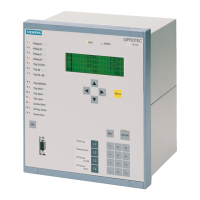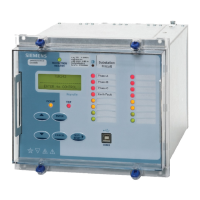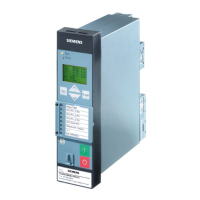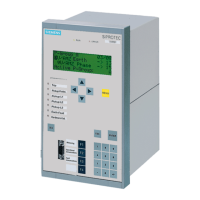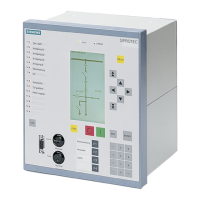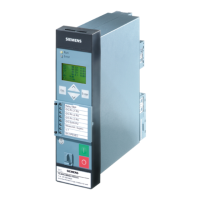7
Ground Differential Protection (87N)
7UT51 v3
94 PRIM-2330C
Since only the ratio of I
0
* to I
0
** is of interest, one can
imagine graphing
I
OP
as a three-dimensional surface
where the dimensions correspond to
I
OP
/ I
0
**(the
normalized value of
I
OP
), ϕ, and I
0
* / I
0
**. Different
values of
k
0
would correspond to different plotted
surfaces. Figure 7.4, Figure 7.5, and Figure 7.6 show
as graphs three cross-sections of such a plot. Each
graph corresponds to one value of I
0
* / I
0
**, with the
vertical axis corresponding to
I
OP
/I
0
* and the horizontal
axis corresponding to ϕ. (Only the range 0° ≤ ϕ ≤ 180°
needs to be shown because of phase-angle
symmetry). The different curves plotted correspond to
different values of
k
0
(a setting).
The interpretation of these graphs will now be
explained.
For any particular combination of I
0
*, I
0
** and
k
0
values, the value of the operating current,
I
OP
, is
affected by ϕ (the phase angle
between and )
in the following way. If ϕ is ±90°, the amplitude of the
stabilization current,
I
STAB
, will be zero, and
equation 7.12 will yield the same value as
equation 7.10, the classical solution. However, as the
phase angle ϕ increases into the range 90° ≤ ϕ ≤ 270°,
the stabilization current
I
STAB
will become larger, and
so the operating current
I
OP
will become smaller
(equation 7.12).
If ϕ is in the range −90° ≤ ϕ ≤ 90°, then
I
OP
is equal to
I
0
* (by definition). This is the same behavior as for the
classical protection solution, so the area is labeled the
“Classical Trip Area.”
The algorithm extends the area in which a trip will be
allowed. Unlike the classical solution, a trip can still
occur even if ϕ is greater than 90° (further to the right
on the graph). It is very important to realize that the
curved boundary of the extended trip area moves
while the relay is operating. At all times, the
instantaneous values of the normalized operating
current value,
I
OP
/ I
0
**, and the phase angle, ϕ, will
plot to a point somewhere
on
the curve corresponding
to the value of the “stabilization factor,”
k
0
. In
Figure 7.4, Figure 7.5, and Figure 7.6 the curved
boundary of the extended trip area is plotted for
several values of
k
0
.
Compare Figure 7.4, Figure 7.5, and Figure 7.6 to see
how, as the ratio of I
0
* to I
0
** increases, the extended
trip area becomes larger. This is appropriate since a
larger ratio means that the measured ground current is
becoming much larger than the calculated zero
sequence current. Hence, it is more likely that the fault
is internal than that it is external, even if CT saturation
is distorting the value of the perceived phase angle
between the currents.
For any given combination of the stabilization factor,
, and ratio of the current amplitudes, I
0
* / I
0
**, there
exists a maximum phase angle
ϕ
MAX
at which the
operating current
I
OP
reaches the value zero. If the
phase angle
ϕ
is greater than
ϕ
MAX
, the operating
current
I
OP
would be negative. To handle this, the
algorithm changes any negative value for
I
OP
to zero,
so no trip occurs.
Address 1904 lists the corresponding value of
ϕ
MAX
for
values of
k
0
when I
0
* / I
0
** = 1.
7.3 Second Harmonic
Restraint
The amplitude of the second harmonic of the
differential current, ID (equation 7.8), is calculated to
detect the effect of inrush. If this amplitude exceeds a
corresponding setting (typically 15% of the
fundamental value of ID), the trip signal will be
blocked. But, if an internal fault with CT-saturation
occurs during inrush, the trip signal must not be
blocked. This situation is handled by disabling
second-harmonic blocking if the magnitude of the
fundamental component of the differential current ID
exceeds a separate setting (typically ten-times the
nominal current of the transformer winding that the
ground differential algorithm is protecting).
The restraint can be limited to a specified time
duration, or to a maximum ground current magnitude
(see Section 7.6 on page 96).
If the operating point remains below 70% of the trip
threshold settings for two full cycles, the 87N function
will dropout (reset).
0
k

